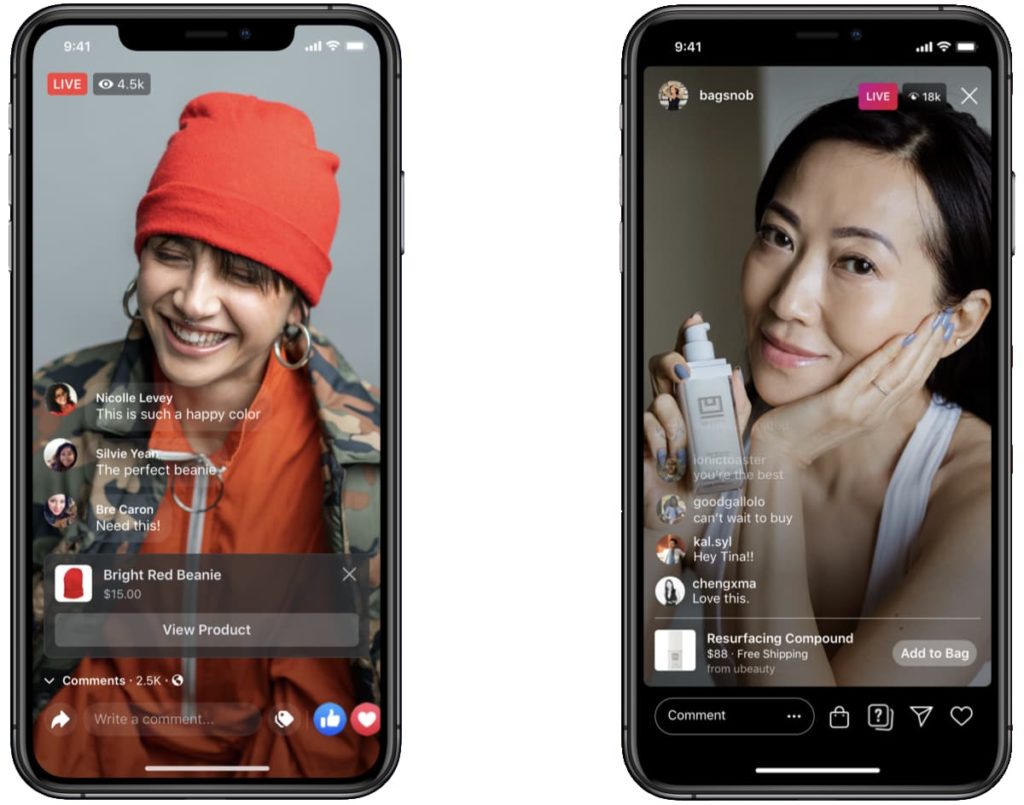NTWRK is a livestream shopping app that “seamlessly blends entertainment and commerce.” The company only sells high-end merchandise and exclusive drops. And at the start of the pandemic, NTWRK prepared for the worst like many others.
Company President, Moksha Fitzgibbons, explains in an interview the concern over potential supply-side issues, access to talented hosts and artists, and the willingness of an audience to spend disposable income on luxury goods in a time of crisis.
Then, after the emergence of COVID-19, their sales surged 400%.
That is—and will remain—the power of live shopping.
It had already conquered the Chinese market, and many US businesses and marketers knew it was a huge opportunity. Of them, most were either nervous of unfamiliar territory or in the midst of planning a slow transition.
But before America could catch up on its own, the pandemic pushed online businesses forward. With consumers in lockdown, livestream shopping was the closest thing to an in-person buying experience.
Now, it is undeniably the future.
What Is Livestream Shopping?
Livestream shopping combines commerce with live video entertainment, often on social media, to give consumers an engaging experience where they can buy with confidence from home. The video host shares products and interacts with the audience who can purchase from the livestream.

Image from TikTok Newsroom of cosmetic live shopping examples.
This practice (also called live shopping, live commerce or live video shopping) is similar to old-school televised shopping experiences that made it easy for people to buy from home after seeing a product on TV.
The two biggest television shopping networks, QVC (Quality Value Convenience) and HSN (Home Shopping Network), are now both owned by the Qurate Retail Group and have also performed well since the pandemic.

Image from USA Today of an HSN show.
While livestream shopping makes the transition from the TV to websites and apps on mobile devices, the basic concept remains: buyers watch as hosts discuss, demonstrate and review products in real-time.
Companies usually hire a key opinion leader (KOL) or key opinion consumer (KOC) to host the show and interact with the audience. Celebrities and influencers are the common preference.
Consumers, able to see how the product looks and works in action, can then ask questions and provide feedback through a chat attached to the video. Getting answers gives them the confidence to buy. Meanwhile, brands gain insight regarding consumer needs and uncertainties.
Interacting with audiences in this way, and allowing audiences to engage with each other, helps develop a brand community and better consumer relationships—both important to creating loyal customers.
A crucial element in livestreaming commerce is a level of entertainment or connection to the host, as this is what encourages people to watch. Live shopping videos often include product launches, tutorials, interviews, games, quizzes, or giveaways. They are not meant to be infomercials.
The more a livestream involves the audience, the more successful it will be, which is why many include chat functionalities and reaction buttons. An effective tactic is to let the audience decide what the stream covers by commenting or participating in polls.
Where It Began: The History of Live Shopping
The concept of live shopping blossomed in the late 70s to early 80s with television shopping networks. These networks targeted women and stay-at-home moms who spent their days in the house. By demonstrating and pitching products on TV, they were able to sell more by making shopping errands more convenient for the primary purchasers of the household.
With the advent of the internet (and YouTube in particular), sellers soon learned that they could post product videos and take advantage of promotional product placement through influencers and internet stars.
At the same time, ecommerce took over the convenience of at-home purchasing. Being able to shop online on one’s own time while conducting research and comparing products became the most powerful of tools.
Then, the final ingredient: social media introduced social selling. People began to share products they found online and gain inspiration from social media influencers.
Once social media platforms realized the money they could make off social commerce, their transition into live shopping platforms was inevitable. Facebook Shops and Instagram Checkout were among the first to give businesses live shopping options.

Image from Coywolf of FB and IG live shopping.
In turn, other livestream shopping platforms began to pop up, borrowing social and interactive elements like live reaction emojis and commenting.
Now, modern live shopping combines the convenience of ecommerce, the social aspect of social apps, and the real-life imitation of shopping networks.
And while pre-recorded product videos are a great tool for converting users on product pages, livestreams add an interactive element to video marketing that brings buyers in.
From China to the US
Livestream shopping was a Chinese phenomenon first, but its level of success is an indicator of its potential in the US.
Take, for example, Alibaba—a Chinese-based online retailer comparable to Amazon. In 2016, Alibaba launched Taobao Live, a service that combined livestream broadcasts with ecommerce stores.
In 2020, a mere four years later, Taobao Live generated over 400 billion yuan (61.7 billion USD) in gross merchandise volume. The same year, despite China’s growing regulation of the live ecommerce sector, the platform’s daily active users increased 100%.
But live shopping in China also grew beyond Taobao:
- Over 10 million ecommerce livestreams were hosted in the country in the first half of 2020 alone.
- And in one 2020 survey, two-thirds of Chinese consumers admitted to purchasing products through a livestream in the past year.
China’s biggest livestreaming star is Huang Wei, known as Viya on her show. With record audiences as high as 37 million, Viya sells all kinds of products from makeup, cars and houses to furniture and toothbrushes. She gained a lot of public attention in 2020 for selling a rocket launcher for 5.6 million USD.
Of course, COVID-19 doubled Viya’s viewership.
And while livestream shopping is now making fast headway in the US, America’s biggest brands weren’t waiting for the US to catch up. Tesla, P&G and Kim Kardashian are among those to have sold products on Viya’s show.
When Kim appeared as a guest to introduce her new perfume to the Chinese market in 2019, she sold 15,000 bottles in minutes.

Image from Alizila of Kim Kardashian on Viya’s show.
As in China, ecommerce stores based in the US will continue to experience a surge in live shopping as the trend picks up and more platforms adopt the technology.
Though a Chinese-owned company, TikTok recently joined the ranks of social platforms with live shopping and product linking capabilities available in the US.
Even now, American brands are learning to take advantage of livestreams on their turf. Both Nordstrom and The Home Depot host sessions on their websites.
Who Buys Live?
In terms of demographics, Generation Z and millennials are the largest contributors to live shopping audiences. If your online store sells to these groups, livestreaming isn’t an option.
Still, that doesn’t mean businesses targeting older audiences shouldn’t start learning as soon as possible. Live video commerce is beginning to draw in middle-aged and older consumers, and it’s not an entirely new concept for these generations to adjust to due to their familiarity with televised shopping networks.
A good practice is to keep in mind the demographics and interests of users on each platform. Facebook serves audiences that are older on average than audiences on other social platforms. Always go where your audience is.
As for the industries benefiting, fashion leads the way, but everything from fresh produce to appliances is sold on livestreams.
Popular Livestream Shopping Platforms
If you own or work for an ecommerce brand, there are a few different platforms you can use to host live commerce sessions:
- Social media platforms like Facebook, Instagram and TikTok
- Livestream platforms like Twitch
- Exclusively live shopping platforms like ShopShops or TalkShopLive
- Niche-focused live shopping platforms like NTWRK
- 3rd-party sites like Amazon with its Amazon Live Creator app
- On your website, like Nordstrom does
- Ecommerce-specific streaming services like Livescale
The largest and simplest platforms to use are social media platforms with live commerce capabilities. Even so, shopping-specific platforms may help you target niche audiences and reach new consumers, while your website gives you the most control.
What Are the Benefits of Live Selling?
Considering the present and future state of live shopping, you may have picked up on a few natural benefits, like making sales and remaining competitive.
Still, more benefits exist for ecommerce stores that embrace live commerce. For one thing, it has the potential to be more effective and engaging than advertising—and can cost less.
1. Increased Discoverability and Traffic
One of the fastest and most recognizable benefits of live selling is increasing discoverability and website traffic. Whether you host streams on your website or direct viewers there from a livestreaming platform, you ultimately increase your website traffic and the chances of completing a sale.
Discoverability is also a vital component to the number of visitors you have; no one will visit and buy if they don’t know you exist. In a huge way, livestreaming on other platforms increases your discoverability by opening you up to the potential buyers on those platforms.
2. Higher engagement and Better Relationships
Livestreaming ecommerce is more than an opportunity to make a sale; it’s a chance to form a connection. Many brands are removed from their customers—a mere entity with products they enjoy.
With livestreams, a human element enters the dynamic. Suddenly there are real people behind a product, and customers can interact with someone other than a customer service rep.
It’s much easier to form a connection with a living, breathing person. Thus, these interactions breed higher engagement and loyalty.
3. Improved Brand Appeal and Differentiation
The interaction and connection that takes place during a livestream is also an excellent opportunity to further differentiate a brand, creating stronger associations and memories.
After all, we recall what’s unique, and we buy what we recall.
4. Shorter Customer Journeys
When a customer purchases from a livestream, they tune in, click a link to a product page, and buy a product, motivated by what they watched. Sometimes this customer is a returning buyer; sometimes, they newly discovered you on the platform.
In the former case, you may have encouraged them to try a new product. In the latter, you just sped up the purchasing journey and skipped the consumer decision-making process.
Either way, it was a streamlined sale.
You can further increase the number of viewers who move from discovery to sale in one session by incorporating limited-time offers and deals.
5. Fewer Returns
Selling with live shopping also results in fewer returns, saving the expense and hassle. It makes sense: people who buy from a livestream have a better idea of what to expect from a product.
According to Coresight founder and CEO, Deborah Weinswig, stores experience 50% lower returns when buyers purchase through a livestream event.
The Face of Your Livestream Matters
It’s worth noting that the person who hosts your livestream is a critical consideration. While a few people already interested in your products may tune in to a livestream, a key person of interest is vital to growth.
You may not need a millionaire celebrity or an influencer with millions of followers, but you do need someone who fits your product and that people can recognize or come to love.
In Viya’s case, her followers are as into her as the products she promotes.
Whether your brand has its own face already or needs to borrow one, viewers are more interested in livestreams hosted by those they are inspired by or want to befriend.
In most cases, micro-influencers are both cheaper and more effective than large-scale celebrities.
Get Started With Live Video Shopping
To any ecommerce store that hasn’t begun live selling: now is the time. And getting started doesn’t have to be scary.
Eventually, you may want to try streaming commerce sessions on your website and cycling the data provided into improving your business and marketing strategies. But as you’re starting out, it’s okay to use a platform like Instagram and track basic KPIs.
The idea is to start somewhere and continue to grow your live sessions from there. Just make sure to keep the viewer at the heart of every choice. Your goal is to add value.
Mike George, president and CEO of Qurate Retail, put it best:
“Too many new players seem intent on flash over substance…Even in the virtual world, it’s still about the power of human connection and the joy of discovery—wandering into your favorite shop, having interesting conversations, learning the stories behind the products, and getting inspired.”
Moving forward, we can expect more industries to begin selling products and services through livestream shopping. Surely enough, AR and VR will also make a home in this realm.
In other words, it’s better to get used to the technology sooner rather than later.


